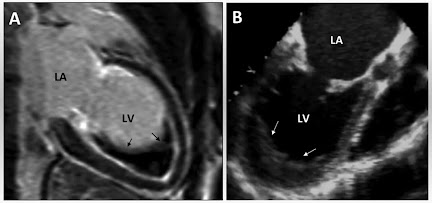Primary Atypical Pneumonia / Viral Pneumonia / Mycoplasmal Pneumonia / Interstitial Pneumonia
Viral pneumonia is characterised by patchy inflammatory changes, generally confined to interstitial tissue of the lungs without any alveolar exudate. Most of the cases are mild and momentary but some cases may be severe and fulminant.
Etiology : Interstitial pneumonia occasionally associated with psittacosis (Chlamydia) and Q fever (Coxiella). Viruses that cause viral pneumonia -
i. Respiratory Syncytial Virus (RSV) - (Most common).
ii. Mycoplasma pneumoniae.
iii. Influenza and para-influenza viruses.
iv. Adenoviruses.
v. Rhinoviruses.
vi. Coxsackieviruses.
vii. Cytomegaloviruses (CMV).
In most cases, the infection of upper respiratory tract remains such as common cold. It may be extend to lower respiratory tract and involve the interstitium of the lungs. Other conditions that may be accelerate to the viral pneumonia i.e. malnutrition, chronic debilitating diseases and alcoholism.
MORPHOLOGICAL FEATURES :
Grossly : Depending upon the severity of infection, the involvement may be patchy to massive and widespread consolidation of one or both the lungs.
- The lungs are heavy, congested and subcrepitant.
- Cut surface of the lung exudes small amount of frothy or bloody fluid.
- Sometime pleura also involve.
Histologically : Hallmark of the viral pneumonia is the interstitial nature of the inflammatory reaction.
1. Interstitial inflammation : There is thickening of the alveolar walls due to -
- Congestion.
- Oedema.
- Mono-nuclear inflammatory infiltrate includes lymphocytes, macrophages and some plasma cells.
2. Necrotising bronchiolitis : This is characterised by foci of necrosis of the bronchiolar epithelium due to -
- Inspissated secretions in the lumina.
- Mono-nuclear infiltrate in the walls and lumina.
3. Reactive changes : The lining epithelial cells of the bronchioles and alveoli proliferate in the presence of virus and may form multi-nucleated giant cells and syncytia in the bronchiolar and alveolar walls. Sometime, viral inclusions (intranuclear or intracytoplasmic) are found specially in pneumonia that cause by cytomegalovirus.
4. Alveolar changes : In severe cases, the alveolar lumina may contain - oedema fluid, fibrin, scanty inflammatory exudate and coating of alveolar walls by pink, hyaline membrane.
COMPLICATIONS : Most of the cases of viral pneumonia recover completely. But some complications may show -
CLINICAL FEATURES : In most of the cases of viral pneumonia initially seen upper respiratory symptoms -
4. Alveolar changes : In severe cases, the alveolar lumina may contain - oedema fluid, fibrin, scanty inflammatory exudate and coating of alveolar walls by pink, hyaline membrane.
 |
| Microscopic appearance of viral pneumonia |
COMPLICATIONS : Most of the cases of viral pneumonia recover completely. But some complications may show -
- Bacterial infection and it's complications.
- Interstitial fibrosis and permanent damage ( in severe cases).
|
Features
|
Lobar Pneumonia
|
Lobular Pneumonia
|
Interstitial Pneumonia
|
|
Definition
|
It is an acute bacterial infection
of a part of lobe or entire lobe or even two lobes of one or both the lungs.
|
It is the infection of terminal
bronchioles that extend into the surrounding alveoli resulting in patchy
consolidation of lung.
|
It is characterized by patchy
inflammatory changes generally confined to interstitial tissue without any
alveolar exudates.
|
|
Etiology
|
Pneumococci, Staphylococcal pneumonia.
|
Staphylococci, Streptococci etc.
|
Respiratory Syncytial Virus (RSV), Mycoplasma pneumoniae.
|
|
Morphology
|
Stage of congestion (1-2 days),
Red hepatisation (2-4 days),
Grey hepatisation (4-8 days),
Resolution (8-9 days)
|
Patchy consolidation with central
granularity, alveolar exudate, thickened septa.
|
Patchy to massive and widespread
consolidation of one or both the lungs.
|
|
Clinical features
|
Shaking, Chills, Fever, Malaise, Chest pain, Dyspnoea,
Tachycardia, Tachypnoea and Cyanosis.
|
Shaking, Chills, Fever, Malaise, Chest pain, Dyspnoea,
Tachycardia, Tachypnoea and Cyanosis, Mottled patches lung in X-rays.
|
Initially – Fever, Headache, Muscles pain.
Later – Dry, Hacking, Cough with retrosternal burning.
|
|
Complications
|
Organisation, Pleural effusion,
Empyema, Lung abscess, Metastatic infection.
|
Organisation, Pleural effusion,
Lung abscess, Empyema.
|
Interstitial fibrosis and
permanent damage.
|
CLINICAL FEATURES : In most of the cases of viral pneumonia initially seen upper respiratory symptoms -
- Fever
- Headache
- Muscle-ache.
After few days -
- Dry, Hacking, Non-productive cough with retrosternal burning appears due to tracheitis and bronchitis.
- Blood film shows neutrophilia.
- Chest X-rays shows patchy or diffuse consolidation.
- Cold agglutinin in the serum are elevated in 50% cases of mycoplasmal pneumonia and 20% cases of adenovirus infection ( absent in other forms of viral pneumonia).
Related Posts -






No comments:
Post a Comment
Please do not enter any spam link in the comment box